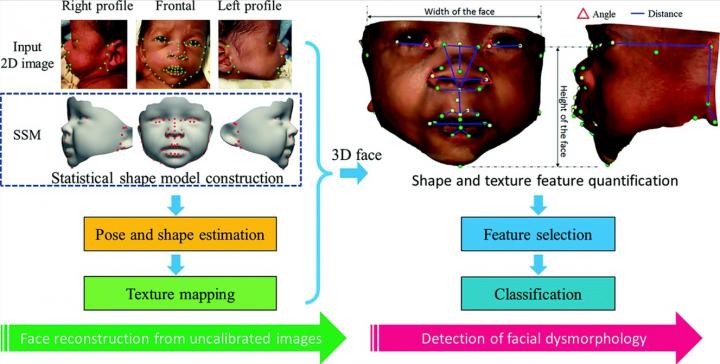Developed by Araceli Morales, Gemma Piella and Federico Sukno, members of the Department of Information and Communication Technologies, together with researchers from the University of Washington

Credit: © Springer Nature Switzerland AG 2019.
Each year, over a million children are born with a genetic disease. Although about half of genetic syndromes present facial dysmorphology, abnormal facial features are often subtle at birth and their identification by paediatricians can prove challenging. Delays and errors in diagnosis have a significant impact on mortality and morbidity associated with genetic syndromes. By way of example, the average accuracy in the detection of one of the most studied genetic syndromes, Down syndrome, by a trained paediatrician is as low as 64% in the US, and so methods for the early detection of genetic syndromes become very important.
Today, facial analysis of children from photographs is a technique that allows early identification of genetic syndromes. However, images may suffer problems of calibration and illumination. Although 3D photography overcomes some of these problems, 3D scanners to quantify craniofacial dysmorphology in children are expensive and often not available at all health centres. A recent study presents a new method to optimize facial analysis that enables reconstructing the face in 3D from 2D photographs.
Araceli Morales, Gemma Piella and Federico Sukno, members of the SIMBIOsys research group and of the Cognitive Media Technologies of the Department of Information and Communication Technologies (DTIC) at UPF, together with researchers from the University of Washington (USA) are the authors of this work published on 7 October in the online edition of Lecture Notes in Computer Science. The article describes the new optimization method to perform 3D facial reconstructions of the shape of children’s faces from uncalibrated 2D photographs using a new statistical model.
First, for each 2D photo, the new method estimates the camera pose using a statistical model and a set of 2D facial landmarks. Secondly, the method calculates the camera pose and the parameters of the statistical model by minimizing the distance between the projection of the estimated 3D face in the image plane of each camera and the observed 2D face geometry.
“Using reconstructed 3D faces, we automatically extract a set of 3D geometric and appearance descriptors and we use them to train a classifier to identify facial dysmorphology associated with genetic syndromes”, explains Araceli Morales, first author of the article who is working on this research for her doctoral thesis which is being supervised by Federico Sukno.
The face reconstruction method on 3D photographs was evaluated in 54 subjects (age range 0-3 years), and “our classifier identified genetic syndromes in reconstructed 3D faces from 2D photographs with 100% sensitivity and a specificity of 92.11%”, the authors explain in their article.
###
Media Contact
UPF
[email protected]
Original Source
https:/
Related Journal Article
http://dx.




